
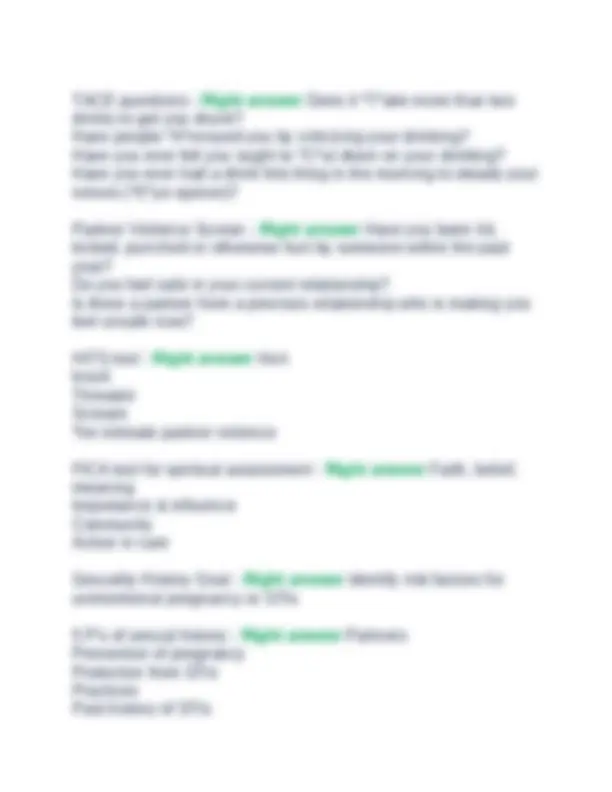
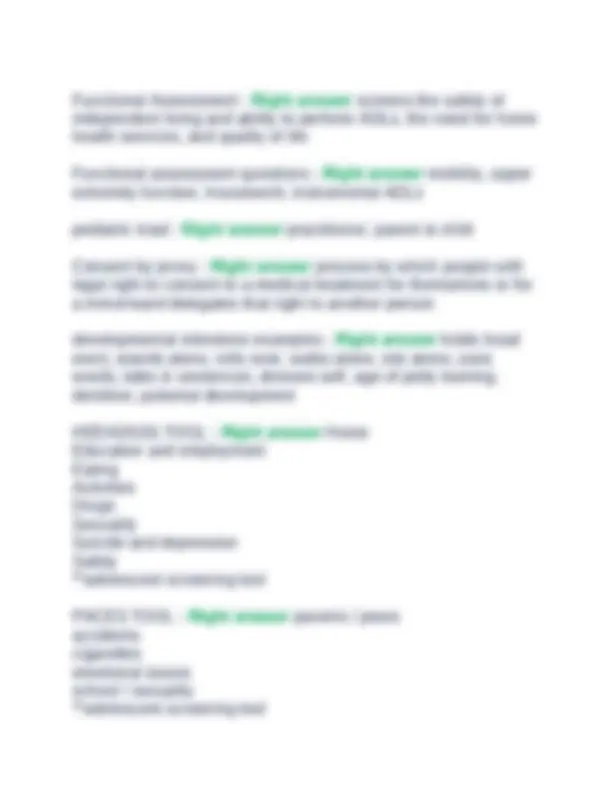
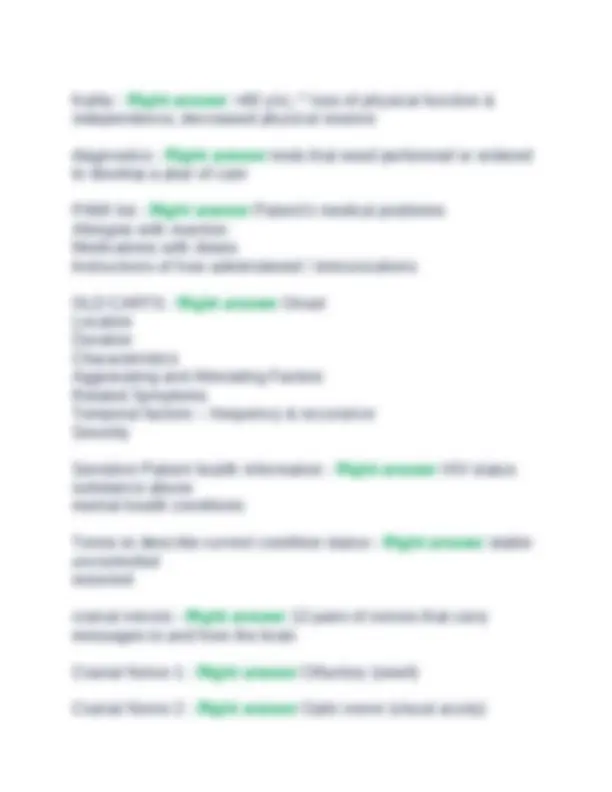
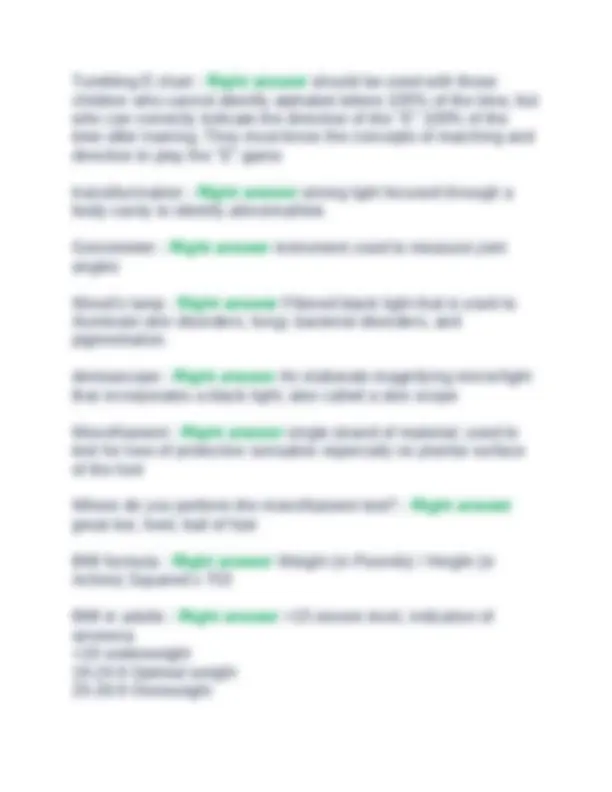
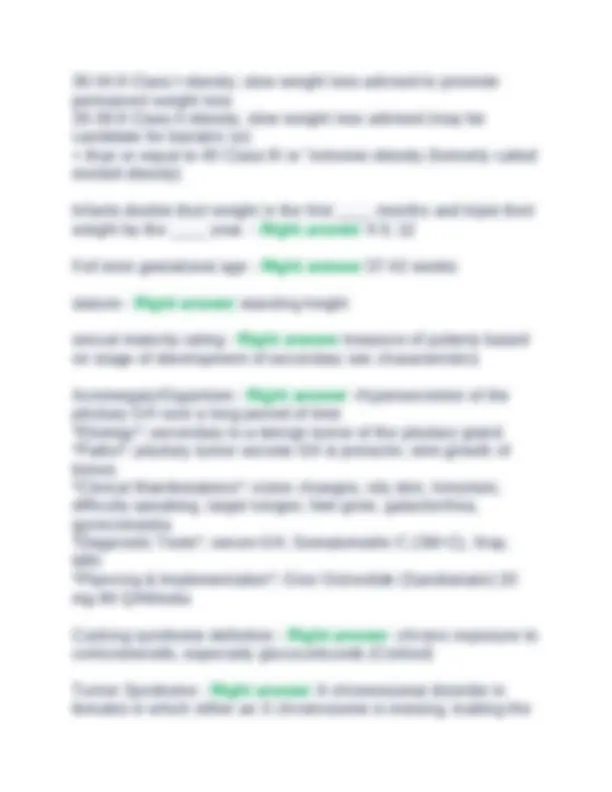
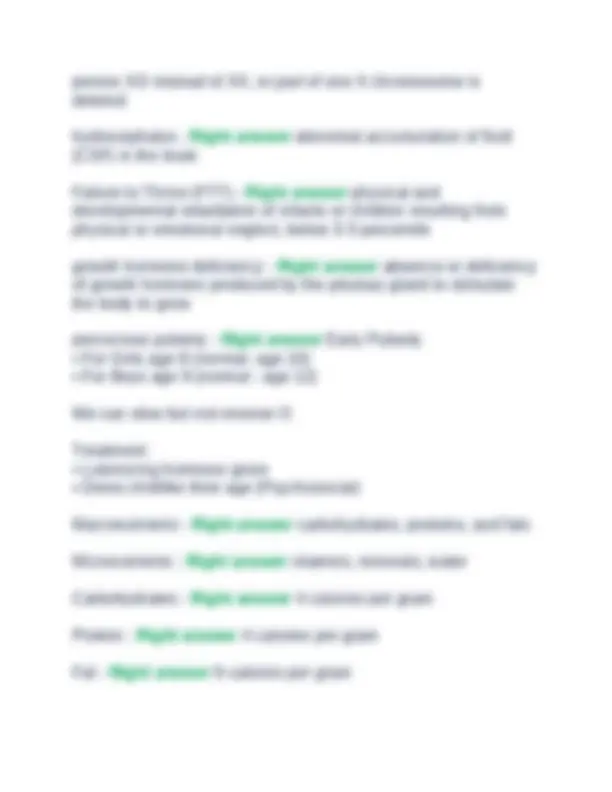
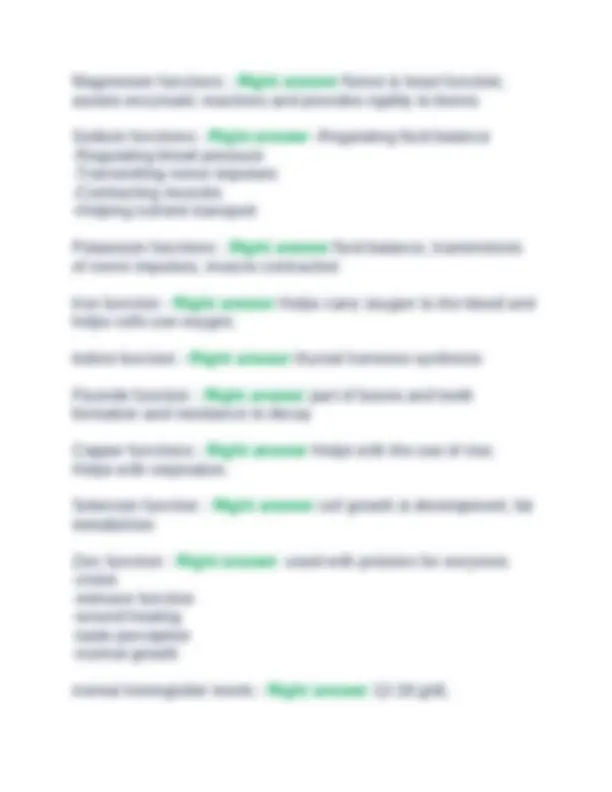
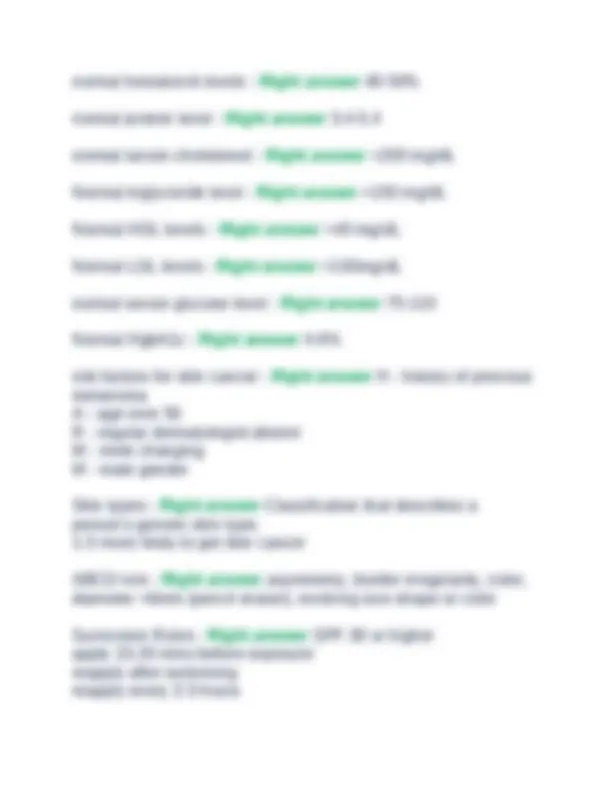
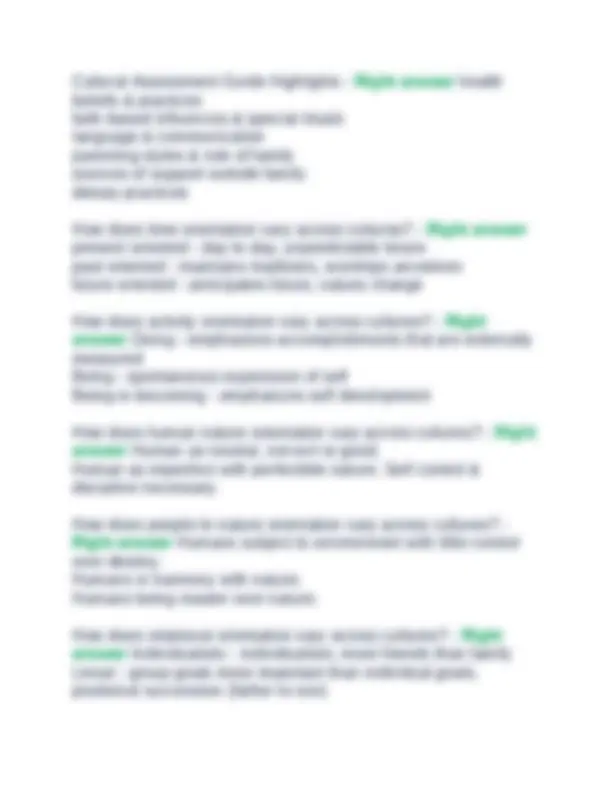
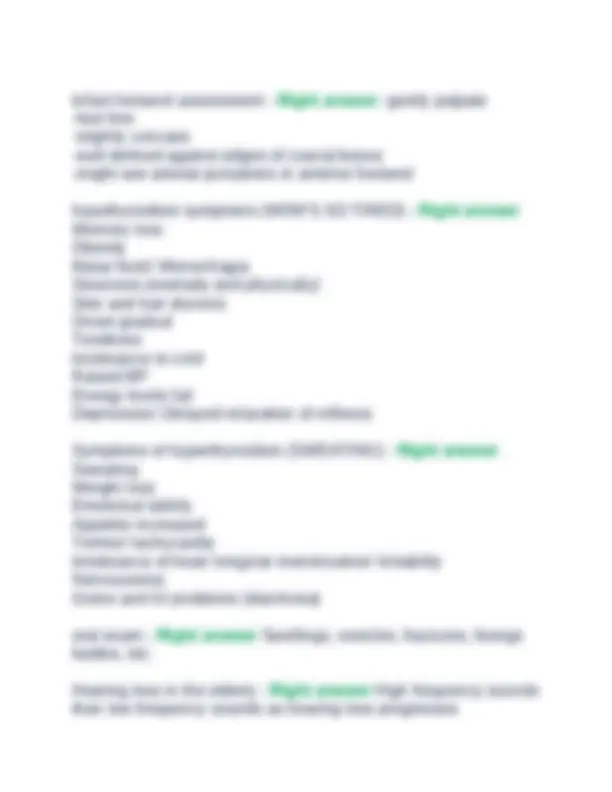
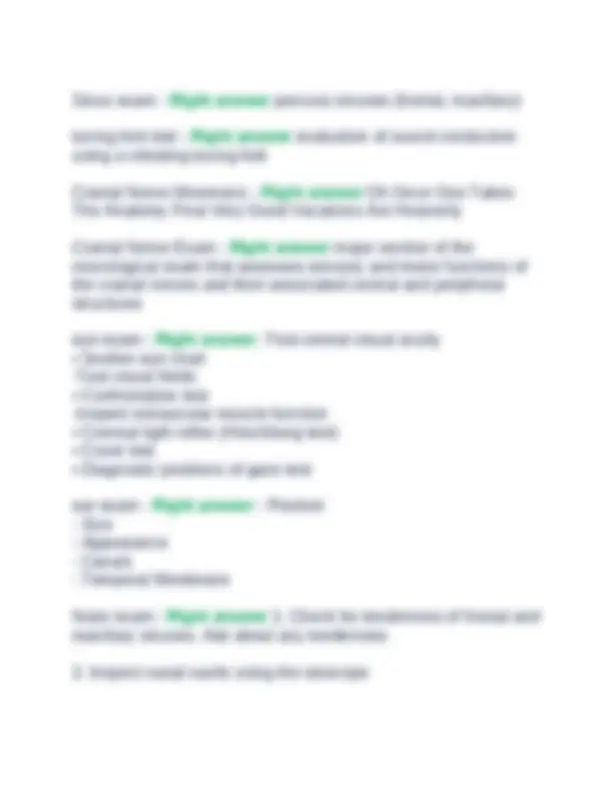
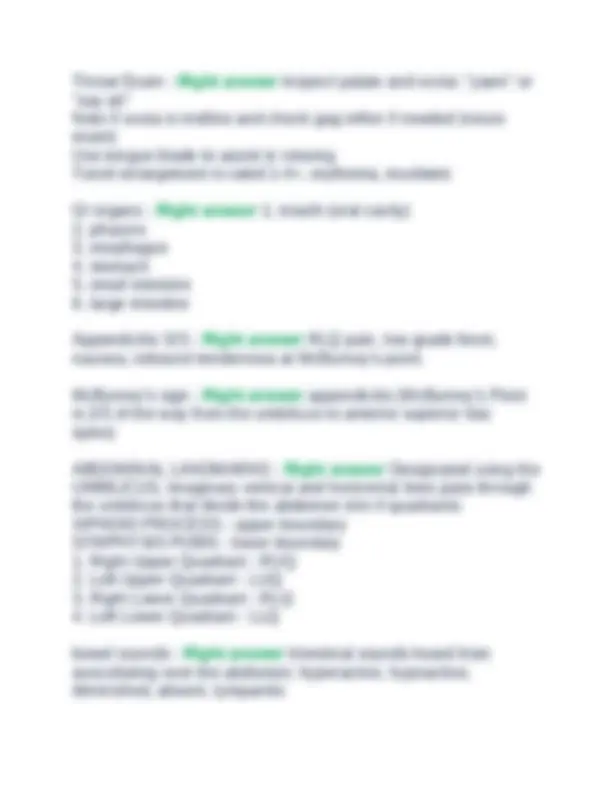
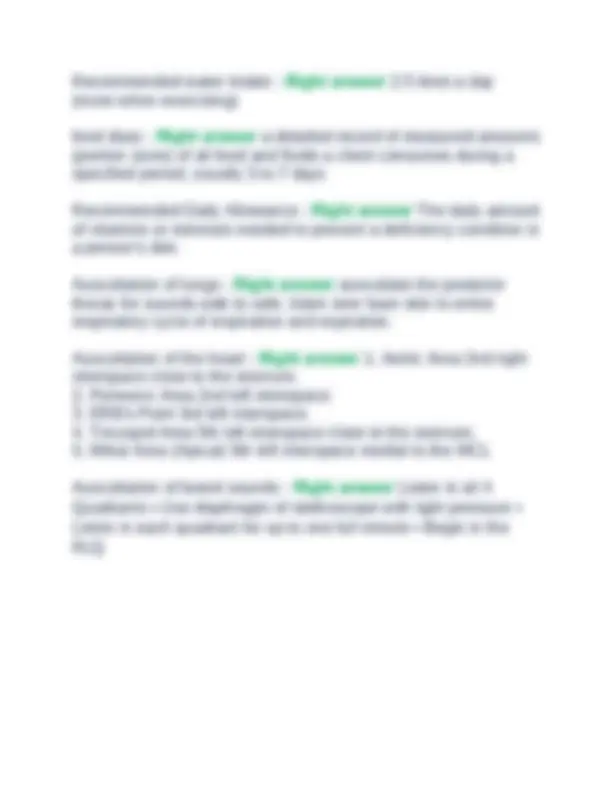


Study with the several resources on Docsity

Earn points by helping other students or get them with a premium plan


Prepare for your exams
Study with the several resources on Docsity

Earn points to download
Earn points by helping other students or get them with a premium plan
Community
Ask the community for help and clear up your study doubts
Discover the best universities in your country according to Docsity users
Free resources
Download our free guides on studying techniques, anxiety management strategies, and thesis advice from Docsity tutors
Advanced Health Assessment Midterm Study Right answer Material 2024
Typology: Exams
1 / 21

This page cannot be seen from the preview
Don't miss anything!














S O A P note - Right answer a method of documentation employed by health care providers to write out notes in a patient's chart Subjective, Objective, Assessment and Plan A B C D skin lesion assessment - Right answer Asymmetry Border irregularity Color isn't uniform Diameter >6cm (pencil eraser) Evolving size, shape and color Preferred qualities of a first impression - Right answer honesty, candor, openness, flexibility, eager, explanatory, open to questions patient centered care - Right answer providing care that is respectful of and responsive to individual patient preferences, needs, and values and ensuring that patient values guide all clinical decisions 4 C's of effective communication - Right answer courtesy comfort connection confirmation Open ended questions goal - Right answer patient's description of answer direct question goal - Right answer seeking specific information
Leading question goal - Right answer Limiting information to one focus / subject Reasons patients avoid the full story of the illness - Right answer dementia, alcoholism, illness, sexual uncertainties, domestic violence, child abuse Potential Barriers to Communication - Right answer - Curiosity about you
Functional Assessment - Right answer screens the safety of independent living and ability to perform ADLs, the need for home health services, and quality of life Functional assessment questions - Right answer mobility, upper extremity function, housework, instrumental ADLs pediatric triad - Right answer practitioner, parent & child Consent by proxy - Right answer process by which people with legal right to consent to a medical treatment for themselves or for a minor/ward delegates that right to another person developmental milestone examples - Right answer holds head erect, stands alone, rolls over, walks alone, sits alone, uses words, talks in sentences, dresses self, age of potty training, dentition, pubertal development HEEADSSS TOOL - Right answer Home Education and employment Eating Activities Drugs Sexuality Suicide and depression Safety **adolescent screening tool PACES TOOL - Right answer parents / peers accidents cigarettes emotional issues school / sexuality **adolescent screening tool
fraility - Right answer >80 y/o;; ^ loss of physical function & independence, decreased physical reserve diagnostics - Right answer tests that need performed or ordered to develop a plan of care PAMI list - Right answer Patient's medical problems Allergies with reaction Medications with doses Instructions of how administered / immunizations OLD CARTS - Right answer Onset Location Duration Characteristics Aggravating and Alleviating Factors Related Symptoms Temporal factors -- frequency & occurance Severity Sensitive Patient health information - Right answer HIV status substance abuse mental health conditions Terms to describe current condition status - Right answer stable uncontrolled resovled cranial nerves - Right answer 12 pairs of nerves that carry messages to and from the brain Cranial Nerve 1 - Right answer Olfactory (smell) Cranial Nerve 2 - Right answer Optic nerve (visual acuity)
How to write a plan of care - Right answer additional studies referrals / consultations pharm management nonpharm management pt education IPPA - Right answer Inspection Palpation Percussion Auscultation how to approach a visually impaired patient - Right answer identify yourself inform pt if leaving room environmental orientation how to approach a hearing impaired patient - Right answer pt's choice of communication method face the patient not the interpreter Autonomic hyperreflexia (dysreflexia) - Right answer Massive, uncompensated cardiovascular response to stimulation of the sympathetic nervous system Stimulation of the sensory receptors below the level of the cord lesion Snellen chart - Right answer chart containing symbols that is used in the testing of visual acuity HOTV test - Right answer the child is given a board containing a large H, O, V, T. the examiner points to a letter on the wall chart, and the child matches the correct letter on the board held in his or her hand
Tumbling E chart - Right answer should be used with those children who cannot identify alphabet letters 100% of the time, but who can correctly indicate the direction of the "E" 100% of the time after training. They must know the concepts of matching and direction to play the "E" game transillunination - Right answer strong light focused through a body cavity to identify abnormalities Goniometer - Right answer instrument used to measure joint angles Wood's lamp - Right answer Filtered black light that is used to illuminate skin disorders, fungi, bacterial disorders, and pigmentation. dermascope - Right answer An elaborate magnifying mirror/light that incorporates a black light; also called a skin scope Monofilament - Right answer single strand of material; used to test for loss of protective sensation especially on plantar surface of the foot Where do you perform the monofilament test? - Right answer great toe, heel, ball of foot BMI formula - Right answer Weight (in Pounds) / Height (in inches) Squared x 703 BMI in adults - Right answer <15 severe level, indicative of anorexia <19 underweight 19-24.9 Optimal weight 25-29.9 Overweight
person XO instead of XX, or part of one X chromosome is deleted. hydrocephalus - Right answer abnormal accumulation of fluid (CSF) in the brain Failure to Thrive (FTT) - Right answer physical and developmental retardation of infants or children resulting from physical or emotional neglect, below 3-5 percentile growth hormone deficiency - Right answer absence or deficiency of growth hormone produced by the pituitary gland to stimulate the body to grow percocious puberty - Right answer Early Puberty
Resting energy expenditure (REE) - Right answer the amount of energy required to maintain basic body functions basal metabolic rate (BMR) - Right answer the rate at which the body burns energy when the organism is resting Anthropometrics - Right answer The measurement of the size, proportions, and range of motion of the human body. Fat soluble vitamins - Right answer Vitamins A, D, E, K water soluble vitamins - Right answer B vitamins and vitamin C Vitamin A function - Right answer integrity of the skin, vision in dim light, wound healing Vitamin D function - Right answer -promotes bone mineralization (makes calcium and phosphorus available to blood that bathes bones) -assists in immune function Vitamin E function - Right answer antioxidant that protects erythrocytes and membranes from damage (E for Erythrocytes) Vitamin K function - Right answer blood clotting and bone formation Vitamin C function - Right answer -production and maintenance of collagen -enhances immune response -does not prevent colds -assists in iron absorption -antioxidant
Magnesium functions - Right answer Nerve & heart function, assists enzymatic reactions and provides rigidity to bones Sodium functions - Right answer -Regulating fluid balance -Regulating blood pressure -Transmitting nerve impulses -Contracting muscles -Helping nutrient transport Potassium functions - Right answer fluid balance, transmission of nerve impulses, muscle contraction Iron function - Right answer Helps carry oxygen to the blood and helps cells use oxygen. Iodine function - Right answer thyroid hormone synthesis Fluoride function - Right answer part of bones and teeth formation and resistance to decay Copper functions - Right answer Helps with the use of iron. Helps with respiration. Selenium function - Right answer cell growth & development, fat metabolism Zinc function - Right answer -used with proteins for enzymes -vision -immune function -wound healing -taste perception -normal growth normal hemoglobin levels - Right answer 12-18 g/dL
normal hematocrit levels - Right answer 40-50% normal protein level - Right answer 3.4-5. normal serum cholesterol - Right answer <200 mg/dL Normal triglyceride level - Right answer <150 mg/dL Normal HDL levels - Right answer >40 mg/dL Normal LDL levels - Right answer <130mg/dL normal serum glucose level - Right answer 75- Normal HgbA1c - Right answer 4-6% risk factors for skin cancer - Right answer H - history of previous melanoma A - age over 50 R - regular dermatologist absent M - mole changing M - male gender Skin types - Right answer Classification that describes a person's genetic skin type. 1-3 more likely to get skin cancer ABCD rule - Right answer asymmetry, border irregularity, color, diameter >6mm (pencil eraser), evolving size shape or color Sunscreen Rules - Right answer SPF 30 or higher apply 15-20 mins before exposure reapply after swimming reapply every 2-3 hours
Collateral - group goals more important than individual goals, relationships with peers emphasized Beneficence (Definition) - Right answer "do good" ; Duty to promote the patients welfare. Serve the patient and public-at- large. Competent and timely delivery of care within the bound of clinical circumstances presented by the patient. Ethical Decision Making Process - Right answer 1. Identify the ethical dilemma
Palpation -capillary refill -texture -firmness -adherence to nailbed Thyroid exam - Right answer locate/inspect trachea feel for deviation locate thyroid just below cricoid cartilage observe patient swallow displace trachea to rt/left and ask to swallow note shape, size, consistency abnormal nails - Right answer white spots - zinc deficiency spoon shaped nails - iron deficiency splinter hemorrhage - injury to brittle nail Psoriasis characteristics - Right answer 1. Thickened patches of inflamed, red skin, frequently covered by silvery scales
Sinus exam - Right answer percuss sinuses (frontal, maxillary) tuning fork test - Right answer evaluation of sound conduction using a vibrating tuning fork Cranial Nerve Mnemonic - Right answer Oh Once One Takes The Anatomy Final Very Good Vacations Are Heavenly Cranial Nerve Exam - Right answer major section of the neurological exam that assesses sensory and motor functions of the cranial nerves and their associated central and peripheral structures eye exam - Right answer -Test central visual acuity
Throat Exam - Right answer Inspect palate and uvula: "yawn" or "say ah" Note if uvula is midline and check gag reflex if needed (neuro exam) Use tongue blade to assist in viewing Tonsil enlargement is rated 1-4+, erythema, exudates GI organs - Right answer 1. mouth (oral cavity)